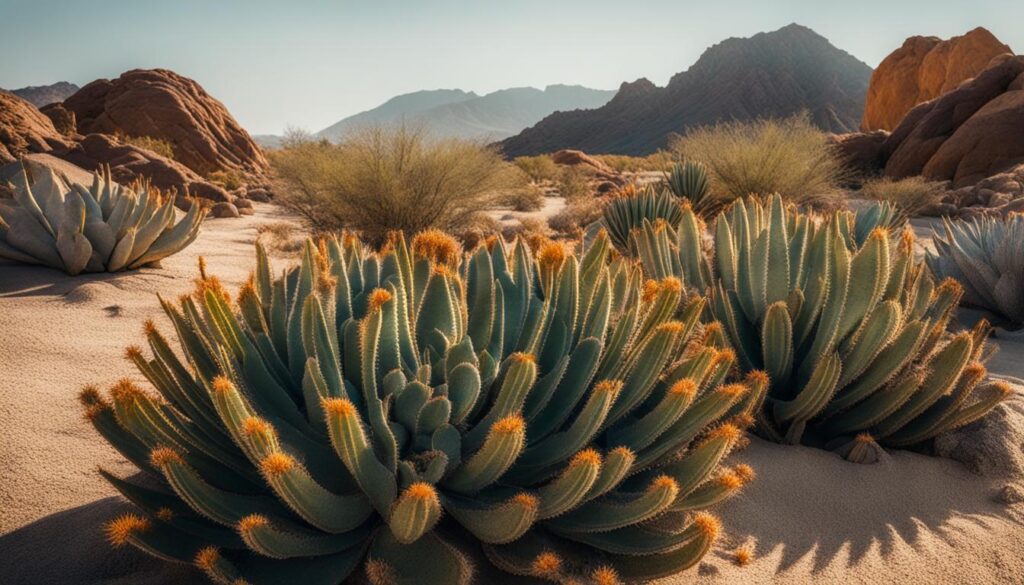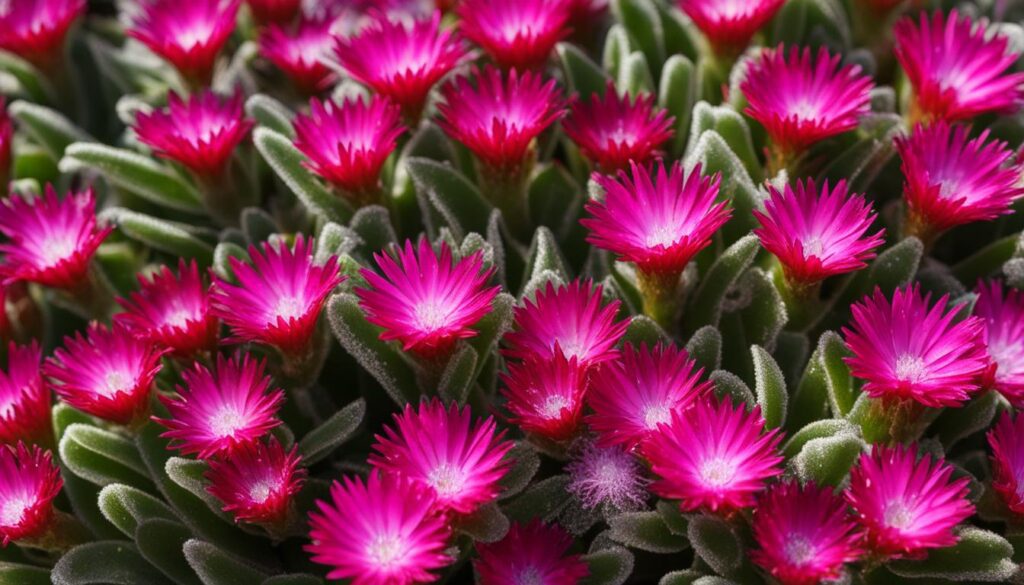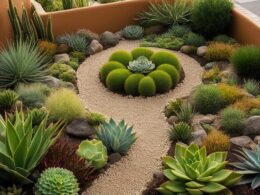Are you looking to create a beautiful and sustainable garden while conserving water and minimizing environmental impact? Xeriscaping, a type of landscaping that focuses on low-water-use plants and water-wise techniques, is the solution for you. By incorporating eco-friendly soil treatments, you can unlock nature’s best for your xeriscape garden.
With xeriscapes, you can embrace sustainable gardening practices that not only enhance the beauty of your landscape but also promote water conservation and environmental stewardship. By using eco-friendly soil treatments, you can create a thriving garden that requires minimal water and reduces the need for chemical fertilizers and pesticides.
- Eco-friendly soil treatments are essential for creating a sustainable xeriscape garden.
- Xeriscaping focuses on low-water-use plants and water-wise techniques.
- Xeriscaping promotes water conservation and reduces environmental impact.
- Using eco-friendly soil treatments minimizes the need for chemical fertilizers and pesticides.
- Eco-friendly soil treatments help create a thriving garden with minimal water requirements.
Xeric Plant Options for a Vibrant Garden
When creating a vibrant xeriscape garden, it’s essential to choose the right xeric plants. These plants are specifically adapted to thrive in arid conditions and require minimal water once established. By incorporating a variety of xeric plant options, you can add beauty, color, and diversity to your water-wise garden. Here are some popular choices:
- Perennials: Agastache, Coneflower, and Coreopsis are stunning perennials that can withstand dry conditions and bloom year after year.
- Herbs: Lavender and Rosemary not only add fragrance and flavor to your garden but are also well-suited to xeriscapes with their water-saving properties.
- Shrubs: Butterfly Bush and Mahonia are drought-tolerant shrubs that provide both color and structure to your xeriscape garden.
- Trees: Quaking Aspen and Olive are excellent choices for shade and cooling relief while requiring minimal water.
By incorporating these xeric plant options into your garden, you can create a vibrant oasis that thrives even in arid climates. Their ability to conserve water and withstand dry conditions makes them perfect choices for a sustainable and low-maintenance xeriscape garden.
“The beauty of xeric plants is that they not only survive in dry conditions but also thrive, adding color, texture, and interest to your xeriscape garden.”
In addition to their water-saving properties, these xeric plants attract beneficial insects and wildlife, creating a diverse and thriving ecosystem within your garden. With a thoughtful selection of perennials, herbs, shrubs, and trees, you can create a xeriscape garden that is not only visually appealing but also environmentally-friendly and sustainable.
| Plant Type | Popular Xeric Plant Options |
|---|---|
| Perennials | Agastache, Coneflower, Coreopsis |
| Herbs | Lavender, Rosemary |
| Shrubs | Butterfly Bush, Mahonia |
| Trees | Quaking Aspen, Olive |
Xeriscaping Basics for Successful Gardening
Xeriscaping basics are essential for achieving successful gardening in water-wise landscapes. By understanding your hardiness zone, the amount of sun your location receives, and implementing proper soil preparation techniques, you can create a thriving xeriscape garden. This section will guide you through the fundamental aspects of xeriscaping that will help you conserve water and maintain beautiful plantings.
Understanding Your Climate and Sun Exposure
Before starting your xeriscape garden, it is crucial to understand your climate and the specific sun and shade locations in your yard. Different plants have different sunlight requirements, so mapping out your yard and identifying areas of full sun, partial shade, and deep shade will aid in choosing the appropriate plants for each area.
Preparing Your Soil for Water Retention
Proper soil preparation is key to maximizing water retention and promoting healthy root growth in xeriscapes. Begin by tilling the soil and incorporating organic matter, such as compost or well-rotted manure, to improve its ability to hold moisture. This enhances the water-holding capacity of the soil and reduces the need for frequent watering.
Selecting Low-Water-Use Plants
Choosing low-water-use plants is at the core of xeriscaping. Look for plants that are native to your region or are well-adapted to arid conditions. These plants have evolved to thrive with minimal watering once established. Consider incorporating a mix of drought-tolerant perennials, shrubs, and grasses to create a diverse and visually appealing xeriscape garden.
By following these xeriscaping basics, you can create a beautiful, low-maintenance garden that conserves water and flourishes in arid climates. Implementing proper soil preparation techniques, understanding your climate and sun exposure, and selecting low-water-use plants will contribute to the sustainability of your xeriscape garden.
Strategies for Preventing Ice Formation on Parking Lots
Preventing ice formation on parking lots is essential for maintaining safety and preserving the integrity of the pavement. By implementing effective anti-icing techniques and employing proper maintenance practices, you can minimize the risk of accidents and ensure smooth vehicular and pedestrian movement. Here are some strategies to consider:
Pre-wetting Salt and Sand
One of the most effective anti-icing techniques is pre-wetting salt and sand before application. When salt and sand are pre-wetted, they adhere better to the pavement, creating a tackier surface that enhances their ice-melting and traction properties. This prevents snow and ice from bonding with the pavement, making it easier to remove and reducing the formation of hazardous icy patches.
Power Sweeping Methods
Regular sweeping and debris cleanup are crucial for preventing ice formation. Advanced power sweeping methods using pneumatic pressure effectively remove debris, including loose gravel, leaves, and other accumulations that can contribute to the formation of ice. By keeping the surface clean and free of obstructions, you can minimize the risk of ice formation and maintain a safe environment for vehicles and pedestrians.
With the combination of pre-wetting salt and sand and utilizing power sweeping methods, you can significantly reduce the formation of ice on parking lots. These strategies, when implemented as part of a comprehensive ice prevention plan, contribute to the overall safety and functionality of parking areas.
| Anti-Icing Technique | Benefits |
|---|---|
| Pre-wetting salt and sand | Enhances ice-melting and traction properties |
| Power sweeping methods | Removes debris and prevents ice formation |
The Benefits of Xeriscaping for the Environment
Xeriscaping offers numerous benefits for the environment. By embracing eco-friendly gardening practices and implementing water-wise landscaping techniques, xeriscapes contribute to water conservation and sustainable landscaping.
One of the key advantages of xeriscaping is its significant water conservation capabilities. By using low-water-use plants and reducing water consumption, xeriscaping helps conserve water, which is a precious resource. This is particularly important in arid climates where water scarcity is a pressing issue. Xeriscapes can reduce outdoor water use by up to 50-75% compared to traditional landscaping methods, making them an effective solution for sustainable water management.
In addition to water conservation, xeriscaping also promotes environmental stewardship by reducing the need for chemical fertilizers and pesticides. Xeriscape gardens rely on the natural characteristics of drought-tolerant plants, minimizing the use of toxic chemicals that can harm the ecosystem. The absence of chemical runoff helps preserve water quality and protects natural habitats.
Furthermore, xeriscaping creates habitats for pollinators and other beneficial insects, supporting biodiversity. Native plants used in xeriscape gardens attract bees, butterflies, and other pollinators, which play a vital role in plant reproduction and the overall health of ecosystems. By providing a habitat for these beneficial insects, xeriscaping contributes to the preservation of biodiversity and the balance of nature.
Summary
- Xeriscaping helps conserve water and is a sustainable solution for water-wise landscaping.
- By reducing the need for chemical fertilizers and pesticides, xeriscaping promotes a healthier ecosystem.
- Xeriscaping creates habitats for pollinators, supporting biodiversity.
Table: Environmental Benefits of Xeriscaping
| Benefits | Description |
|---|---|
| Water conservation | Xeriscapes can reduce outdoor water use by 50-75% compared to traditional landscaping methods. |
| Reduced chemical usage | Xeriscaping minimizes the need for chemical fertilizers and pesticides, protecting water quality and preserving natural habitats. |
| Biodiversity support | Xeriscape gardens create habitats for pollinators and beneficial insects, promoting biodiversity and ecological balance. |
Xeriscaping Resources: Your Guide to Success
When it comes to xeriscaping, having access to the right resources can make all the difference in creating a thriving and water-wise garden. Whether you’re a beginner or an experienced gardener, these essential tools, guidebooks, and online communities will help you achieve xeriscaping success.
Guidebooks: Your Roadmap to Beautiful Xeriscapes
Guidebooks dedicated to xeriscaping provide valuable insights, practical advice, and inspiration for creating stunning and sustainable xeriscape gardens. These resources cover a wide range of topics, from plant selection and soil preparation to water-saving techniques and maintenance tips. Discover expert recommendations and step-by-step instructions that will empower you to transform your landscape into a water-wise oasis.
“Guidebooks offer a wealth of knowledge and guidance for xeriscaping enthusiasts. They provide a comprehensive understanding of xeriscaping principles, plant selection, and sustainable gardening practices.”
Online Communities: Connect and Learn from Fellow Gardeners
Joining online communities and forums dedicated to xeriscaping allows you to connect with like-minded gardeners, share experiences, and exchange valuable insights. Engage in discussions, ask questions, and learn from the collective knowledge of a vibrant community. Whether you need advice on plant care, design ideas, or troubleshooting common challenges, these online platforms provide a supportive space for learning and growth.
Innovative Tools: Making Xeriscaping Effortless
The world of xeriscaping is constantly evolving, and innovative tools can make the process easier, more efficient, and more enjoyable. Discover eco-friendly irrigation systems that optimize water usage, planting tools designed for xeric plant care, and other cutting-edge gadgets that enhance your xeriscaping experience. Embrace these innovative tools and embrace the future of sustainable gardening.
| Resources | Description |
|---|---|
| Guidebooks | Comprehensive xeriscaping guides offering expert advice and inspiration. |
| Online Communities | Engage with fellow gardeners, ask questions, and learn from shared experiences. |
| Innovative Tools | Eco-friendly gadgets that enhance the xeriscaping process and make it more efficient. |
By utilizing these xeriscaping resources, you’ll be equipped with the knowledge, support, and tools necessary to create a beautiful and sustainable xeriscape garden. Whether you’re seeking inspiration, guidance, or a sense of community, these resources will empower you on your xeriscaping journey.
The Power of Delosperma: A Hardy Xeriscape Ground Cover
When it comes to selecting a ground cover for your xeriscape garden, Delosperma, commonly known as the ice plant, stands out as a resilient and beautiful choice. With its ability to thrive in arid conditions and its vibrant daisy-like flowers, Delosperma brings both practicality and aesthetic appeal to your landscape. This hardy succulent ground cover requires minimal watering once established, making it an ideal option for water-wise gardens.
One of the key advantages of Delosperma is its low-maintenance nature. It is a resilient plant that can withstand drought, heat, and poor soil conditions. This makes it an excellent choice for both beginner gardeners and those seeking a low-effort solution for their xeriscapes. The ice plant’s ability to spread and fill in empty spaces also makes it a great ground cover option.
Delosperma thrives in sunny locations with well-draining soil. It is important to prepare the soil properly before planting to ensure the plant’s success. Adding organic matter like compost and ensuring good drainage will provide the optimal growing conditions for Delosperma. While Delosperma is generally hardy, it may not tolerate extremely cold temperatures. Therefore, adequate protection and soil preparation are essential if you live in a region with harsh winters.
With its hardiness, vibrant flowers, and low-maintenance nature, Delosperma is a versatile and reliable ground cover for xeriscapes. Whether you want to add pops of color to your landscape or create a visually appealing carpet of blooms, Delosperma will not disappoint. Embrace the power of Delosperma and enjoy the beauty and resilience it brings to your xeriscape garden.
Delosperma Varieties for Xeriscapes
| Delosperma Variety | Height | Flowering Time | Flower Colors |
|---|---|---|---|
| D. cooperi | 3-6 inches | Summer | Pink, Purple |
| D. nubigenum | 2-4 inches | Spring | Yellow |
| D. basuticum | 3-6 inches | Summer | Orange, Red |
Creating Colorful Harmony: Flowers in the Vegetable Garden
Introducing flowers into your vegetable garden not only adds vibrancy and beauty but also provides numerous benefits for your plants and the ecosystem as a whole. Companion planting flowers alongside your vegetables can attract beneficial insects like bees and butterflies, which play a crucial role in pollination and pest control.
“The hum of bees is the voice of the garden.” – Elizabeth Lawrence
Marigolds, for example, are known to deter pests like aphids and nematodes, while chamomile can attract hoverflies that feed on aphids and other garden pests. Nasturtiums, with their vibrant blooms, can attract pollinators and also serve as a trap crop for aphids, keeping them away from your precious vegetables.
By incorporating flowers into your vegetable garden, you create a harmonious and balanced ecosystem where beneficial insects thrive, promoting healthy plant growth and reducing the need for chemical pesticides. The interplay of colors and textures between flowers and vegetables not only adds visual appeal but also creates a more resilient garden.
| Flower | Benefits |
|---|---|
| Marigold | Deters aphids and nematodes |
| Chamomile | Attracts hoverflies for natural pest control |
| Nasturtium | Attracts pollinators, acts as a trap crop for aphids |
By embracing companion planting and incorporating flowers in your vegetable garden, you not only create a visually stunning and diverse space but also contribute to the overall health and productivity of your garden.
Enhancing Soil Health in Xeriscapes
Soil health plays a vital role in the success of any xeriscape garden. By improving the soil’s structure and water retention capacity, you can ensure that your plants receive the necessary nutrients and moisture to thrive in arid conditions. Incorporating organic matter, implementing mulching techniques, and practicing composting are key strategies for enhancing soil health in xeriscapes.
Organic matter, such as compost, is a valuable resource that provides essential nutrients to the soil. Composting kitchen scraps and yard waste not only reduces waste but also creates nutrient-rich soil amendments. Incorporating compost into the soil improves its fertility, increases water-holding capacity, and enhances microbial activity, resulting in healthier plants.
Mulching is another effective technique for maintaining soil health in xeriscapes. Applying a layer of organic mulch, such as wood chips or straw, around your plants helps regulate soil temperature, prevent moisture evaporation, and suppress weed growth. Mulch acts as a protective barrier, reducing water loss and providing insulation for the soil. It also improves soil structure over time as it decomposes, promoting a healthy environment for plant roots.
Composting is a sustainable practice that not only reduces waste but also enriches the soil. By decomposing organic materials, compost releases valuable nutrients and beneficial microorganisms that enhance soil fertility and structure. You can create a compost pile in your backyard by combining kitchen scraps, yard waste, and other organic matter. Regularly turning the compost pile helps accelerate the decomposition process and ensures a consistent supply of nutrient-rich compost for your xeriscape garden.
Investing in soil health through the incorporation of organic matter, mulching, and composting is essential for the long-term success of your xeriscape garden. By creating a nutrient-rich and moisture-retentive environment, you enable your plants to thrive in water-limited conditions. With healthy soil as a foundation, your xeriscape garden will flourish, showcasing the beauty and resilience of nature.
Are Climate Adaptive Soil Treatments as Effective as Eco-Friendly Soil Treatments for Xeriscaping?
Climate adaptive soil treatments are essential for xeriscaping, as they help soil better withstand harsh weather conditions. Eco-friendly soil treatments for xeriscaping provide effective results too, by promoting water retention and reducing the need for irrigation. Both approaches contribute to sustainable landscaping practices.
Conclusion: Embracing Nature’s Wisdom in Xeriscaping
Xeriscaping is a sustainable gardening practice that allows you to embrace nature’s wisdom while creating beautiful and resilient landscapes. By incorporating low-water-use plants and implementing water-saving techniques, you can minimize water consumption and have a positive impact on the environment.
One of the key benefits of xeriscaping is its contribution to sustainable gardening. By conserving water, xeriscapes help protect this precious resource and promote environmental stewardship. Additionally, xeriscaping reduces the need for chemical fertilizers and pesticides, creating a healthier ecosystem for plants, animals, and beneficial insects.
By focusing on soil health and enhancing its organic matter through techniques like mulching and composting, xeriscaping fosters a thriving environment for plants to grow and thrive. This sustainable approach not only benefits your garden but also improves overall soil quality and reduces waste.
Embracing xeriscaping is not just about creating a beautiful garden; it’s about cultivating a deeper connection with nature and taking responsibility for environmental stewardship. By implementing xeriscaping practices, you can enjoy the benefits of a sustainable garden while making a positive impact on the world around you.














